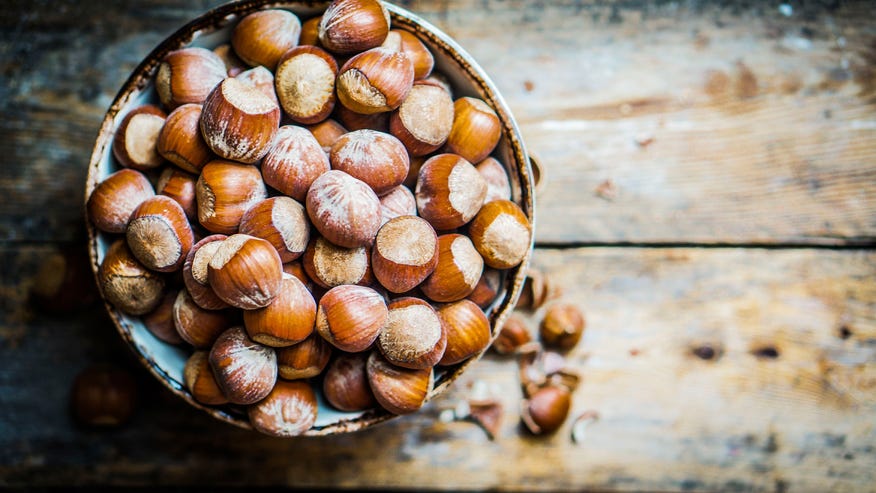With a protein value of approximately 15 percent, the hazelnut, which grows abundantly on hazel trees found in temperate regions throughout northern Europe, would have made a valuable contribution to the Mesolithic diet of the people of Colonsay, as the primary source of protein on an island where wild game was scarce.
Today the hazelnut, and its relative the filbert, both deriving from hazel trees, are consumed widely, perhaps most popularly in the popular breakfast spread Nutella. That invention was the brainchild of one Italian baker Pietro Ferrero, who in 1946 whipped up the first 300 kilogram batch of the spread. Ferrero owned a bakery in Italy’s hazelnut region in the Piedmont. Then called “Pasta Guianduja,” the product caught on. That original recipe called for over 70 percent hazelnuts, whereas in today’s version, sugar and palm oil are the first two ingredients.
Hazelnuts boast a concentration of heart-healthy monounsaturated fats, plenty of B vitamins, calcium, magnesium, potassium, manganese and copper. The nuts are notably a good source of folate, the B vitamin that prevents neural tube deficiency in babies. The nuts are also a good source of dietary fiber, and therefore are beneficial for digestion and healthier intestinal activity.
Above and beyond all this, hazelnuts are richer in proanthocyanidins (PAC’s) than any other nut. The PAC’s in hazelnuts are concentrated in the skins that surround the nut flesh. Proanthocyanidins are super-potent antioxidants that inhibit several aspects of heart disease, help to repair damaged tissue throughout the body, accelerate healing, enhance immune function, and even improve the appearance of skin. This makes hazelnuts, despite their modest profile, titans among the so-called superfoods.
The unique flavor of hazelnuts is due to a compound known as filbertone. Because filbertone has such a pleasing smell, it is used in cosmetics and perfumery. The concentration of filbertone in hazelnuts varies according to variety, with some possessing more flavor than others. Synthetic filbertone is also used to adulterate olive oil, to make it appear to be the more expensive hazelnut oil.
You can find hazelnuts in shells, hazelnuts shelled with the skins on, and blond hazelnuts without skins. For sure the tastiest and most healthy version will be shelled hazelnuts with skins, retaining the full PAC value. Hazelnuts are showing up in trail mixes and nut blends, and they’re great in breakfast cereals or cooked into oatmeal. Hazelnuts make sweet, satisfying snacks. They’re great tossed into a blender shake with almond milk, dates, and a banana.
Due to their pleasant sweet flavor, fatty richness and broad uses, hazelnuts are now cultivated around the world. Turkey is currently the largest producer, but the nuts are also grown in Italy, France, China, the U.S., Canada and Iran. In the U.S., cultivation is concentrated in Oregon’s Willamette Valley, where more than 650 farmers purportedly grow the nuts. ;
Varieties of hazelnuts vary, with different nut sizes, differences in sweetness, firmness, and other characteristics. The Oregon Hazelnut Industry runs a nicely done website that will give you lots of good information on U.S.-grown hazelnuts.
Chris Kilham is a medicine hunter who researches natural remedies all over the world, from the Amazon to Siberia. He teaches ethnobotany at the University of Massachusetts Amherst, where he is Explorer In Residence. Chris advises herbal, cosmetic and pharmaceutical companies and is a regular guest on radio and TV programs worldwide. His field research is largely sponsored by Naturex of Avignon, France. Read more at MedicineHunter.com.


